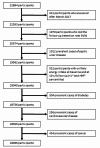Association between the consumption of ultra-processed foods and the incidence of peptic ulcer disease in the SUN project: a Spanish prospective cohort study
- PMID: 38809325
- PMCID: PMC11377682
- DOI: 10.1007/s00394-024-03439-2
Association between the consumption of ultra-processed foods and the incidence of peptic ulcer disease in the SUN project: a Spanish prospective cohort study
Abstract
Purpose: Consumption of ultra-processed foods (UPF) has increased despite potential adverse health effects. Recent studies showed an association between UPF consumption and some gastrointestinal disorders. We evaluated the association between UPF consumption and peptic ulcer disease (PUD) in a large Spanish cohort.
Methods: We conducted a prospective analysis of 18,066 participants in the SUN cohort, followed every two years. UPF was assessed at baseline and 10 years after. Cases of PUD were identified among participants reporting a physician-made diagnosis of PUD during follow-ups. Cases were only partially validated against medical records. Cox regression was used to assess the association between baseline UPF consumption and PUD risk. Based on previous findings and biological plausibility, socio-demographic and lifestyle variables, BMI, energy intake, Helicobacter pylori infection, gastrointestinal disorders, aspirin and analgesic use, and alcohol and coffee consumption were included as confounders.We fitted GEE with repeated dietary measurements at baseline and after 10 years of follow-up. Vanderweele's proposed E value was calculated to assess the sensitivity of observed associations to uncontrolled confounding.
Results: During a median follow-up of 12.2 years, we recorded 322 new PUD cases (1.56 cases/1000 person-years). Participants in the highest baseline tertile of UPF consumption had an increased PUD risk compared to participants in the lowest tertile (HR = 1.52, 95% CI: 1.15, 2.00, Ptrend=0.002). The E-values for the point estimate supported the observed association. The OR using repeated measurements of UPF intake was 1.39 (95% CI: 1.03, 1.87) when comparing extreme tertiles.
Conclusion: The consumption of UPF is associated with an increased PUD risk.
Keywords: Gastrointestinal disorders; NOVA food classification system; Peptic ulcer disease; Ultra-processed food.
© 2024. The Author(s).
Conflict of interest statement
The authors declare that they have no conflict of interest.
Figures
References
-
- Martínez Steele E, Baraldi LG, Louzada ML, Moubarac JC, Mozaffarian D, Monteiro CA (2016) Ultra-processed foods and added sugars in the US diet: evidence from a nationally representative cross-sectional study. BMJ Open 6(3):e009892. 10.1136/bmjopen-2015-009892 10.1136/bmjopen-2015-009892 - DOI - PMC - PubMed



